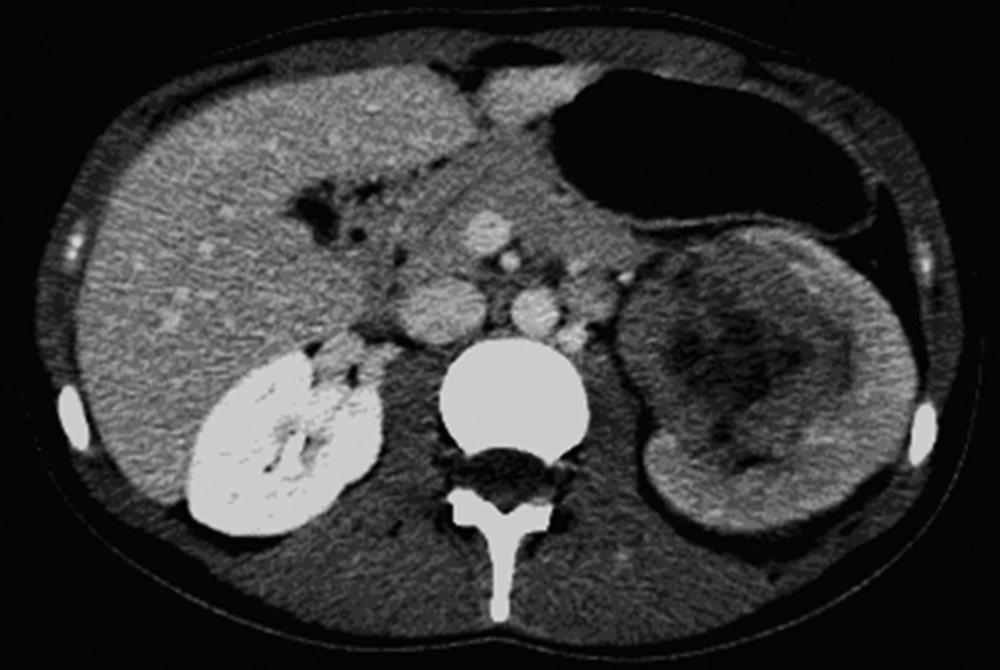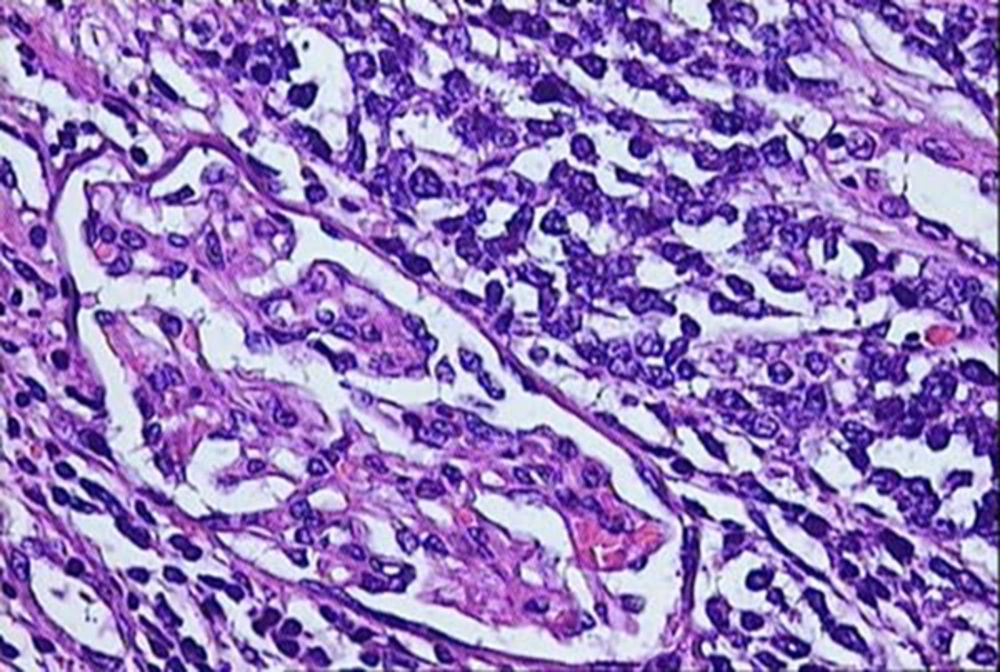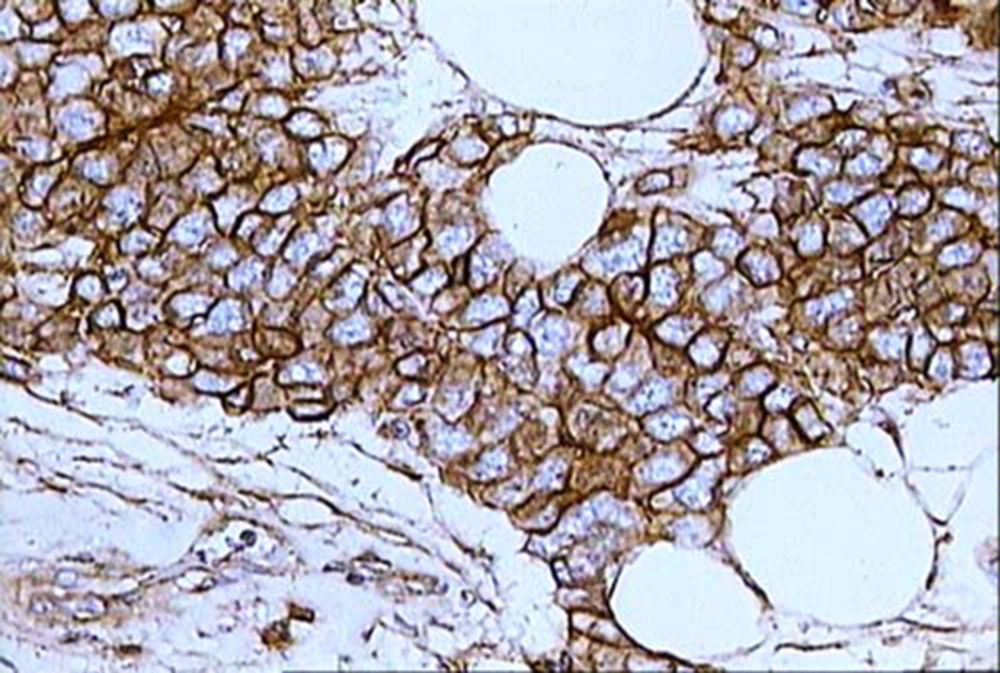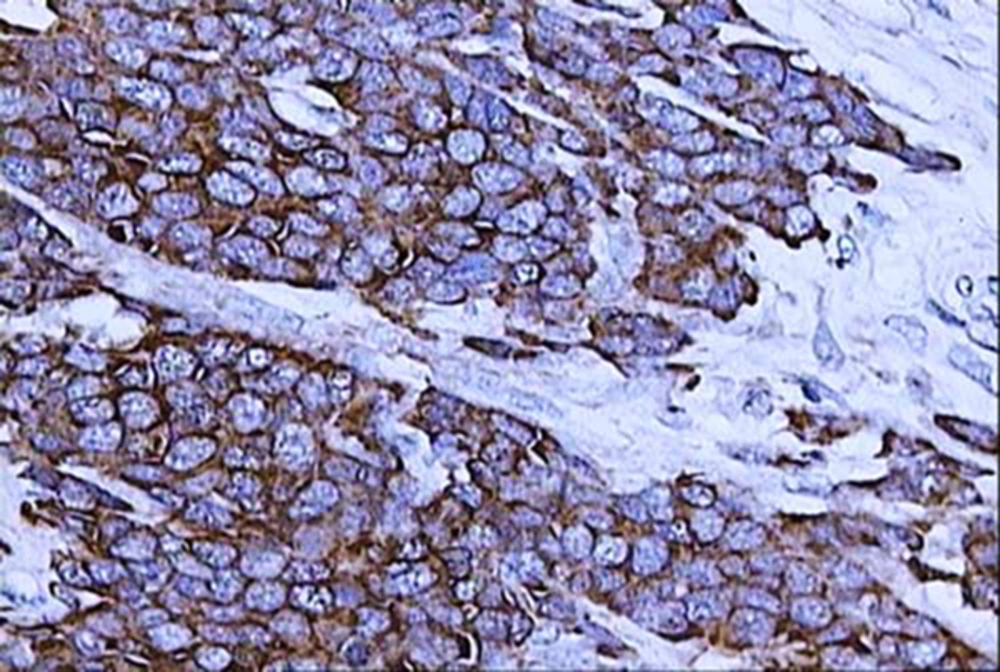1. Introduction
Primitive neuroectodermal tumor (PNET) is a member of the Ewing’s sarcoma/primitive neuroectodermal tumor family of tumors (1). Based on the assumed etiology of these tumors, PNET arises from the neural crest (2, 3). ET/EWS tumors have the same chromosomal translocation [t (11; 22) (q 24; q 12)] registered in 90% of cases (2). PNETs are malignant tumors composed of small, round cell neoplasms that usually present in the form of a bone or soft tissue mass. Peripheral PNETs are usually located in the chest wall and paraspinal regions and less frequently in the genitourinary system (3-5). Renal PNET (rPNET) is a very rare form of ES/PNET tumor that predominantly occurs in older children and adolescents (4, 5). Renal PNETs are usually presented in the literature in the form of case studies and meta-analyses. The five-year disease free survival rate is about 45% - 55% (6). We report the case of a 32-year-old female patient with renal PNET diagnosed nine years and eight months previously, treated with nephrectomy and chemotherapy, and followed up with imaging methods that revealed no signs of disease.
2. Case Presentation
We present the case of 32-year-old female patient who presented to the urologist with fever lasting for the previous two months, usually 37°C to 38°C, with occasional temperature leaps to 40°. Laboratory blood tests showed leukocytosis with cell counts up to 19,000. The patient did not complain of lumbar pain. Urinalysis showed leukocyturia, erythrocyturia, and slight positivity for protein. The patient was treated with a combination of amoxicillin, clavulonic acid, and cefuroxime. Abdominal ultrasound and multiphase CT depicted a large, expansive, heterogenous mass in the lower pole of the left kidney measuring 92 × 59 × 76 mm. CT scans showed a renal neoplastic mass with increased peripheral inhibition and poor central inhibition, possibly due to central necrosis. The tumor was unsharply demarcated from the surrounding parenchyma and pelvic system (Figure 1). Regional lymphadenopathy was present, but there were no signs of propagation in the main renal vein or perinephric fat tissue, and there were no signs of liver or bone metastasis. Chest CT showed no signs of lungs metastasis or mediastinal lymphadenopathy. In order to determine the final histopathological diagnosis, histopathological and immunohistochemical analyses were performed, complemented by reverse transcryptase-polymerase change reaction (RT-PCR). Gross examination of the slitted specimen showed a sharply circumscribed tumor measuring 9 × 6 × 6 cm and replacing a large part of the kidney. The renal tumor displayed infiltrated parenchyma but no expansion into the pelvic system and ureter or signs of spreading into the main renal vein. Gross appearance of the tumor was white-yellow with large necrotic areas. The microscopic analysis of perinephric fat tissue, regional lymph nodes, and the left adrenal gland revealed no signs of metastasis. Microscopic analysis showed that the tumor was composed of solid nests and stripes of tumor cells with small oval and round nuclei, and some of the nuclei contained small nucleoli (Figure 2). The tumor cell cytoplasm was scanty and pink with coarser appearance of chromatin. Mitotic figures were also found. Immunohistochemical analysis included MIC2 gene product/CD 99 (Figure 3), neuron-specific enolase (NSE) (Figure 4), CD3, CD 20, chromogranin, synaptophysin, vimentin, and neurofilament. Immunohistochemical staining revealed positive expression of CD99 and NSE in all tumor cells. The tumor cells did not stain with CD3, CD 20, chromogranin, synaptophysin, vimentin, or neurofilament. RT-PCR analysis for EWS-FLI1 fusion proteins was positive for type II 191 pb and negative for type I 125 pb. Diagnosis of rPNET set on the basis of characteristic morphological characteristics and results of immunohistochemical analysis was confirmed by RT-PCR. After nephrectomy, the patient received 14 cycles of a VAC/IE regiment adjuvant chemotherapy comprised of vincristine, doxorubicin, cyclophosphamide, ifosfamide, and etoposide. Our patient was disease-free for nine years and eight months. Blood and urine laboratory test values were in the normal range.
The study was approved by the institutional ethical committee and conducted according to the principles of the declaration of Helsinki of the world medical association. The authors declare that they have no conflicts of interest. The authors did not receive any grants for writing this article.
3. Discussion
Primary renal PNET is a very rare member of the PNET/EWS family of tumors, which to the best of the authors' knowledge was first described in 1975 by Seemayer et al. (7). The possible etiology of rPNET includes the theory of neural cell intussusception in the kidney during development, the theory of adrenergic fibers that invert into the kidney from the celiac plexus, and the theory of neural crest cells that have migrated to the kidney and begun tumorigenesis (1). Renal PNET most commonly affects children and young adults, with a mean age of 30.4 years and a slight male predominance of 61% (1, 3, 6). Primary rPNETs are usually very aggressive tumors with distant metastasis and local reccurence in more than 50% of patients (5). The overall five-year disease-free survival rate for patients with peripheral PNETs is about 45% - 55% in patients with tumors localized in the kidney (5). Patients with rPNET diagnosed in the advanced stage have a median relapse-free survival of two years (5). Renal PNET can present in various forms with symptoms such as malaise, nephric colic, flank pain, testicular pain, dysuria, dyspnea, dizziness, and clinical signs such as an increase in abdominal circumference, weight loss, a palpable mass, night sweats, fever, hematuria, and varicocele (6). Primary renal PNETs are usually large tumors with a diameter of > 10 cm (8, 9). Our patient had a less common pattern of presentation, she was subfebrile and she had hematuria and no pain in the left lumbar region at the time of diagnosis.
The radiographic features of renal PNETs presented in previously published articles mainly case reports include large renal masses of heterogeneous structure with areas of internal hemorrhage, necrosis, and diffuse large calcification but no signs of extensive parenchyma infiltration (6, 9-11). The same radiological pattern had a tumor formation in our patient's case. The histological characteristics of renal PNET at the light microscopic level are small, uniform round or oval cells with dark nuclei, and in some cases vesicular nuclei and nucleoli can be observed. In most of the cases of rPNET, numerous mytotic figures can be detected. The renal PNET tumor cells commonly contain a minimal amount of cytoplasm within ill-defined borders (1, 3, 12). The tumor cells of renal PNETs can form clusters with a neurofibrillary stromal core and pseudorosettes (Homer-Wright rossetes), which are considered the most diagnostically useful histological feature. However, pseudorosettes are also visible in neuroblastomas (12). Histological differential diagnoses for renal PNET include the „round cell“ tumors of the kidney, such as blastema-predominant Wilm’s tumor, lymphoma, clear cell sarcoma, small cell carcinoma, monophasic poorly differentiated synovial sarcoma, neuroblastoma, desmoplastic round cell tumor, rhabdoid tumor, and rhabdomyosarcoma (1, 3-5, 12). Differential diagnostic problems can be partially resolved with immunohistochemistry (1, 3). MIC2 gene product or CD99 antigen (Cluster of differentiation 99 antigen) is a monoclonal antibody that recognizes the glucoprotein p 30/32. Diffuse membrane positivity on CD99 can be detected in almost all reported cases of PNET, although it is not an absolute biomarker. The specificity of CD99 for diagnosis of PNET has been questioned, especially for differentiation from small cell carcinoma, Wilm’s tumor, and non-Hodgkin's lymphoma (1, 3, 4, 13, 14). Neuron-specific enolase (NSE) is positive in 95% of cases of rPNETs, although it can be positive in neuroblastoma as well (1, 3). Other rPNET commonly positive immunohistochemical markers are S-100, synaptophysin, Leu-7, and vimentin, positive in 48% to 70% of cases (5). The samples in the present case are positively stained on CD99 and NSE, as in most cases of rPNET, but negative for vimentin and synaptophysin, which is atypical for rPNET. WT-1 is an associated tumor supressor gene that is overexpressed in Wilm’s tumor but not in PNET/EWS. Positive results of immunochemistry for the carboxy-terminus of Friend leukemia integration 1 proto-oncogene (FLI-1) proteins on tumor cells is sensitive and highly specific for PNET/EWS. The previously mentioned cytogenetic difference between PNET/EWS and Wilm's tumor cells forms the basis for the immunochemical differential diagnosis with stainings on WT-1 and FLI-1 (3). Chromosomal translocation t (11; 22) (q 24; q 12) can be found in 90% - 95% of renal PNET/EWS; subsequent immunohistochemical staining of the carboxy-terminus of FL1 is sensitive and highly specific for the diagnosis of PNET/EWS, but not characteristic (2, 3). The previously mentioned chromosome translocation results in the formation of a EWS-FLI1 fusion gene, which encodes a chimeric EWS-FLI-1 protein (2). EWS-ET fusion genes are presumed to be the driving force in Ewing’s sarcoma pathogenesis (2). The influence of EWS-FLI1 fusion type on prognosis has not been unequivocally confirmed in previous studies (15). The EWS/FLI1 fusion may be detected directly with the use of RT-PCR or fluorescence in situ hybridization (FISH), otherwise indirectly with standard cytogenetic studies by the t (11; 22) (q 24; q 12) (1). The diagnosic sensitivity of the RT-PCR assay in a study performed by Parham et al. was 80% (1). Our patient had EWS/FLI1 fusion type II detected with RT-PCR, but unlike in most cited studies, the patient presented in this paper had a longer disease-free period.
The combination of surgery and chemotherapy is the most common therapeutic approach for the patient with rPNET (12, 16). Complete nephrectomy complemented with resection of other affected organs or vasculature (e.g., cavotomy) is the standard surgical therapy (12). Adjuvant chemotherapy for PNET/EWS includes a VAC/IE chemotherapeutic regimen (17, 18). Radiation therapy in rPNET is indicated only in extracapsular spread of tumors and tumor residues (5, 16).
Renal PNETs are diagnosed at the advanced stage in 58% to 66% of cases (5, 19). The overall five-year survival rate for rPNETs is between 42% and 67% (5, 16). In the study of Le Deley et al. (15), which included 565 patients, the probability of disease progression or relapse was 41% (95% CI, 37% to 46%) at five years. In the retrospective study of Risi et al. (19), which included 116 published cases of rPNETs from 1975 to 2012, the median overall survival time was 24 months (95% CI 4.5 - 15.1).
Our patient was disease-free for nine years and eight months. During the first three years of follow-up, the patient was monitored by CT, and during the last six years, the patient was monitored with a combination of conventional chest radiographs and MRI of the abdomen and pelvis. To the best of the authors' knowledge, the longest individual disease-free survival period in patients with published medical records of follow-up was 8.7 years; however, the authors were unable to find specific details about treatment regimens (15).
3.1. Conclusion
Renal PNET/EWS should be placed on the list of differential diagnoses in younger symptomatic patients, in whom a variety of diagnostic tests reveal a large tumor mass, because this has a significant impact on the treatment and prognosis. Immunohistochemical and cytogenetic studies play an important role in the diagnosis of rPNET. A combination of complete nephrectomy and adjuvant chemotherapy with a VAC/IE regimen can achieve good results in the treatment of localized rPNET.



